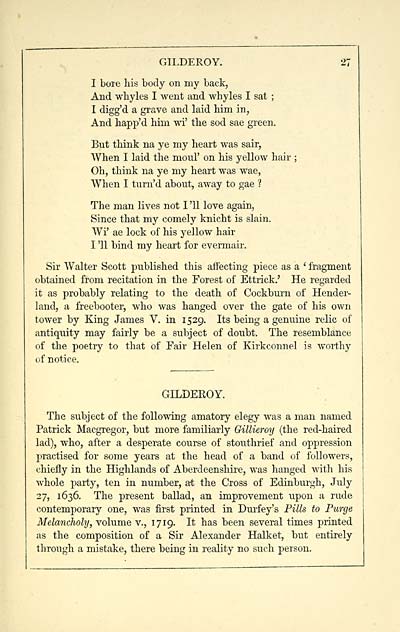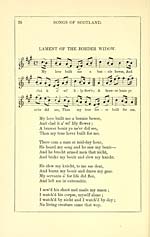Glen Collection of printed music > Printed text > Songs of Scotland prior to Burns
(31) Page 27 - Gilderoy
Download files
Complete book:
Individual page:
Thumbnail gallery: Grid view | List view

GILDEROY. 27
I bore his body on my back,
And whyles I went and whyles I sat ;
I digg'd a grave and laid him in 7
And happ'd him wi' the sod sae green.
But think na ye my heart was sair,
When I laid the moul' on his yellow hair ;
Oh, think na ye my heart was wae,
When I turn'd about, away to gae 1
The man lives not I '11 love again,
Since that my comely knicht is slain.
Wi' ae lock of his yellow hair
I '11 bind my heart for evermair.
Sir Walter Scott published this affecting piece as a ' fragment
obtained from recitation in the Forest of Ettrick.' He regarded
it as probably relating to the death of Cockburn of Hender-
land, a freebooter, who was hanged over the gate of his own
tower by King James V. in 1529. Its being a genuine relic of
antiquity may fairly be a subject of doubt. The resemblance
of the poetry to that of Fair Helen of Kirkconnel is worthy
of notice.
GILDEROY.
The subject of the following amatory elegy was a man named
Patrick Macgregor, but more familiarly Gillieroy (the red-haired
lad), who, after a desperate course of stouthrief and oppression
practised for some years at the head of a band of followers,
chiefly in the Highlands of Aberdeenshire, was hanged with his
whole party, ten in number, at the Cross of Edinburgh, July
27, 1636. The present ballad, an improvement upon a rude
contemporary one, was first printed in Durfey's Pills to Purge
Melancholy, volume v., 17 19. It has been several times printed
as the composition of a Sir Alexander Halket, but entirely
through a mistake, there being in reality no such person.
I bore his body on my back,
And whyles I went and whyles I sat ;
I digg'd a grave and laid him in 7
And happ'd him wi' the sod sae green.
But think na ye my heart was sair,
When I laid the moul' on his yellow hair ;
Oh, think na ye my heart was wae,
When I turn'd about, away to gae 1
The man lives not I '11 love again,
Since that my comely knicht is slain.
Wi' ae lock of his yellow hair
I '11 bind my heart for evermair.
Sir Walter Scott published this affecting piece as a ' fragment
obtained from recitation in the Forest of Ettrick.' He regarded
it as probably relating to the death of Cockburn of Hender-
land, a freebooter, who was hanged over the gate of his own
tower by King James V. in 1529. Its being a genuine relic of
antiquity may fairly be a subject of doubt. The resemblance
of the poetry to that of Fair Helen of Kirkconnel is worthy
of notice.
GILDEROY.
The subject of the following amatory elegy was a man named
Patrick Macgregor, but more familiarly Gillieroy (the red-haired
lad), who, after a desperate course of stouthrief and oppression
practised for some years at the head of a band of followers,
chiefly in the Highlands of Aberdeenshire, was hanged with his
whole party, ten in number, at the Cross of Edinburgh, July
27, 1636. The present ballad, an improvement upon a rude
contemporary one, was first printed in Durfey's Pills to Purge
Melancholy, volume v., 17 19. It has been several times printed
as the composition of a Sir Alexander Halket, but entirely
through a mistake, there being in reality no such person.
Set display mode to: Large image | Transcription
Images and transcriptions on this page, including medium image downloads, may be used under the Creative Commons Attribution 4.0 International Licence unless otherwise stated. ![]()
| Special collections of printed music > Glen Collection of printed music > Printed text > Songs of Scotland prior to Burns > (31) Page 27 - Gilderoy |
|---|
| Permanent URL | https://digital.nls.uk/90576110 |
|---|
| Description | Scottish songs and music of the 18th and early 19th centuries, including music for the Highland bagpipe. These are selected items from the collection of John Glen (1833 to 1904). Also includes a few manuscripts, some treatises, and other books on the subject. |
|---|
| Description | The Glen Collection and the Inglis Collection represent mainly 18th and 19th century Scottish music, including Scottish songs. The collections of Berlioz and Verdi collected by bibliographer Cecil Hopkinson contain contemporary and later editions of the works of the two composers Berlioz and Verdi. |
|---|

